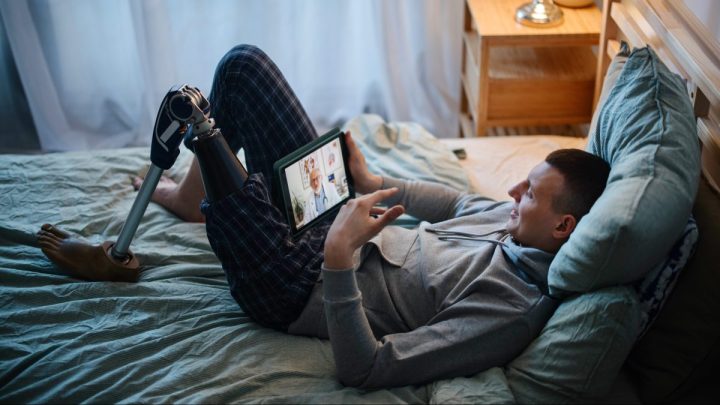
Remote mental health treatment boomed during the pandemic. It’s still going strong.
Remote mental health treatment boomed during the pandemic. It’s still going strong.

The federal public health emergency tied to the COVID-19 pandemic officially ends Thursday.
The pandemic emergency juiced the growth of telehealth services, and a slew of regulatory reforms and waivers to Medicare and Medicaid made remote treatment — and reimbursement for care — possible.
The growth has been particularly strong in telemental health — seeing a counselor, psychologist or other provider for mental health or substance-use therapy by video, phone or text chat. And the explosion of treatment on screens and phones during the pandemic has likely changed the field of mental health care forever.
Since pandemic lockdowns and mask mandates ended, a lot of medical care has gone back to being in-person again. Not so for mental health care. More than a third of it is still delivered via video, phone and apps. It also used to be much more difficult to get reimbursement for remote therapy under Medicare and many employer-based plans. Then COVID came along.
“I think it absolutely unleashed telehealth in a wholly different way,” said JoAnn Volk, research professor and co-director of the Georgetown University Center on Health Insurance Reforms. “They pulled off all the restrictions and paid parity for providers and lowered cost sharing for patients. And it worked.”
Medicare, for instance, now covers therapy and substance-use treatment via video and phone for all patients, regardless of geographic location, said Nirmita Panchal, a senior policy analyst at the Kaiser Family Foundation.
“We’ve seen uptake in particular in rural areas, where even leading up to the pandemic they encountered unique barriers,” she said.
Things like a shortage of providers and long distances to clinics. But urban and suburban folks have embraced telemental health too.
“Knowing that I could do it over Zoom was kind of a game changer,” said Janelle Nanos, a mental health patient in Boston and a business enterprise reporter at The Boston Globe.
“Last year, I started on a project that involved some pretty heavy material, specifically abuse against children, and I was just thinking about really hard things,” she said.
Nanos has done a lot of trauma coverage. She’s now writing a book based on her investigative reporting about parents who sex traffic their kids. (She was named a finalist for the 2023 Pulitzer Prize in feature writing for this work.) Nanos has two young children of her own.
She’s never seen her therapist in person and doesn’t even know where her office is. There’s a $20 insurance copay for every virtual visit. “I don’t have to drive, I don’t have to clear my schedule,” she said. “I can just log on, have that conversation, log off, send her a Venmo and we’re done.”

The shift has been a game changer for therapists too. Katrina Gould is a licensed clinical social worker and has been practicing in Portland, Oregon, for 30 years. Before the pandemic, she barely treated any clients by video or phone, and getting reimbursed by insurance for it was rarely possible.
But early in the pandemic, she was seeing nearly all her clients by video. Gould still sees more than half that way — and is busier than ever.
She does have concerns, though, about missing observations like a patient’s body language. “I still 100% prefer to be in the presence of another person. There’s a lot of information that I can’t get on Zoom.”
Gould now gets reimbursed the same amount by insurance whether she sees a client in person or on screen.
But some other providers aren’t so lucky. Insurance companies can set some of their reimbursement rules, said JoAnn Volk of Georgetown. And she worries they might actually start to restrict in-person therapy to control costs.
“One of the things to keep our eye on is whether or not telehealth is pushed, especially by insurers, to replace in-person visits, that you must use telehealth first or exclusively,” she said.
Volk said some states have passed laws protecting patients’ choice to see providers online or in person and to make sure providers are reimbursed at parity for either kind of care.
There are also concerns around equity and unequal access to broadband, smartphones and computers, she added. Some studies have shown that telemental health has been adopted most by white, higher-income people.
“If we’ve made gaps worse for people who are low-income or racial or ethnic minorities, it needs to be watched and tweaked going forward,” Volk said. “I don’t think we’re going back ever, but we need to make sure that access is equitable.”
Meanwhile, in most cases, you still can’t see a therapist virtually unless they’re licensed in the state where you live.
But few other pre-pandemic barriers to telemental health care remain. Medicare and Medicaid coverage has been extended or made permanent, and many private insurers now cover treatment via video, audio, text and chat.
Telemental health care is here to stay.
There’s a lot happening in the world. Through it all, Marketplace is here for you.
You rely on Marketplace to break down the world’s events and tell you how it affects you in a fact-based, approachable way. We rely on your financial support to keep making that possible.
Your donation today powers the independent journalism that you rely on. For just $5/month, you can help sustain Marketplace so we can keep reporting on the things that matter to you.











